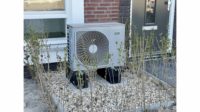Non-condensing indoor gas furnaces would be phased out beginning in 2029 under a plan announced June 13 by the Biden Administration.
The proposal from the Department of Energy (DOE), if adopted, would require new non-weatherized gas furnaces to have an annual fuel utilization efficiencies of at least 95%, meaning they would have to produce at least 95 Btu of heat for every 100 Btu of natural gas consumed. That would ban non-condensing furnaces, which currently must be at least 80% efficient, and is intended to steer consumers toward more efficient technology, like condensing furnaces, which capture additional heat from exhaust gases.
The move would reduce carbon emissions by 373 million metric tons over 30 years, according to a DOE estimate; a homeowner who replaced a non-condensing furnace with a condensing model would save $60 a year in utility costs, the DOE said.
“These efficiency measures not only reduce carbon and methane emissions, but also provide huge material benefits to American households in the form of cleaner air, modernized technology, and cheaper energy,” said Energy Secretary Jennifer Granholm in a press release.
At the Air Conditioning, Heating, and Refrigeration Institute, which represents HVACR manufacturers, president and CEO Stephen Yurek said the rulemaking process is long overdue and the DOE plan will be closely studied there.
“We will be reviewing with our member companies the proposed rule and analysis and will actively participate in the notice-and-comment process to ensure the rule is complete, fair, and adequately reflects the needs of our member companies and the customers they serve,” Yurek said in a prepared statement.
The proposed standard is the administration’s second move toward decarbonization within two weeks. On June 6, President Joe Biden invoked the Defense Production Act (DPA) to expand the manufacture and availability of certain energy-saving technologies, including heat pumps and building insulation. Invoking the DPA paves the way for more federal investment in those technologies.
Gas furnaces account for an estimated 15% of annual residential energy use in the U.S. According to figures from the Census Bureau, more than 47 million homes — more than 38% of all homes in the country — are heated with warm-air natural gas furnaces.
Public Comment Sought
The proposal was announced in a pre-publication Federal Register notice. The energy department will take public comment for 60 days after the proposed rule is officially published in the Register, and has scheduled a public webinar on the proposal for Wednesday, August 3.
Conservation groups hailed the plan, but representatives of the gas industry were critical.
At the American Gas Association, president and CEO Karen Harbert said the group would “thoroughly examine every aspect of this proposed rule” and “vigorously object” if it is found to be “another attempt to put the natural gas industry out of business.” The 104-year-old AGA represents more than 200 local natural gas companies.
“At this moment when natural gas is imperative for our country’s and the world’s stability, placing enormous costs on everyday Americans is wrong-headed at best,” Harbert said in a press release.
Condensing furnaces are more expensive than less-efficient models because of the added heat-capture equipment, and more expensive to install because of ventilation systems that typically require building modifications.
The AGA contends that some older homes, especially in low-income neighborhoods, cannot accommodate the venting requirements, meaning that owners would switch to electric furnaces when equipment is replaced.
“The natural gas industry is working every day on implementing solutions to achieve our cleaner energy goals, and without question there is a better and more inclusive way to make appliances more efficient,” said Harbert.
A statement from HARDI, the Heating Air-conditioning & Refrigeration Distributors International, which represents HVACR wholesalers, noted that the rule would not apply to distributors, who could continue to sell non-condensing furnaces as long as they are in stock.
At the Natural Resources Defense Council, energy efficiency advocate Joe Vukovich said the new standard is overdue.
“Americans have been forced to rely on antiquated and wasteful furnaces for long enough,” Vukovich said in a press release.
“Home heating bills strain the budgets of many households, especially those with low incomes, yet we’re still installing brand-new furnace models that waste a lot of the heat. The Biden administration is right to phase out the most inefficient models,” said Andrew deLaski, executive director of the Appliance Standards Awareness Project, which is based at the American Council for an Energy-Efficient Economy.
The DOE press release noted that Canada has required condensing furnaces for residential use for more than a decade.
A statement from the DOE said the department will notify the media when the proposed standard is published in the Federal Register.








